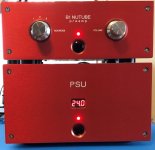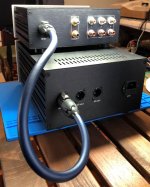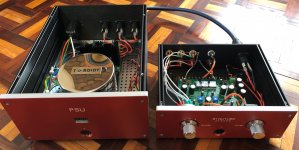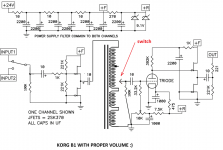Happy New Year!
Here’s my take on the B1.
T7/T8 at 9.5V, no smoke and … great sound 🙂
A big thanks to Nelson Pass and to the DIYAudio crew for another top-notch project.
Next on the workbench: F5, M2, F6 and single-ended Class A Sony VFET (providing I’m able to grab a kit that is).
Here’s my take on the B1.
T7/T8 at 9.5V, no smoke and … great sound 🙂
A big thanks to Nelson Pass and to the DIYAudio crew for another top-notch project.
Next on the workbench: F5, M2, F6 and single-ended Class A Sony VFET (providing I’m able to grab a kit that is).
Attachments
Happy New Year!
Here’s my take on the B1.
T7/T8 at 9.5V, no smoke and … great sound 🙂
A big thanks to Nelson Pass and to the DIYAudio crew for another top-notch project.
Next on the workbench: F5, M2, F6 and single-ended Class A Sony VFET (providing I’m able to grab a kit that is).
😮 That looks amazing! Great job!
Nice build!
What type of connector and cable are you using for the DC power to the amp?
The cable is a double shielded 14AWG cable (ELECAUDIO CS-321B OCC Cable Secteur OCC PTFE 3x2.50mm2 Double shielding O 12mm - Elecaudio) whereas the connectors are Neutrik’s powerCON (NAC3MPX-WOT-TOP | Neutrik & NAC3FX-W-TOP | Neutrik).
I see….so it is a Neutrik.
Have you connected the shields to Gnd?
I once asked Neutrik which connector you use for DC current and they recommended the SpeakOn connectors. Reason was that they only specify AC current for their connectors. With Korg both types are "overkill" 🙂
I always find terminating connectors quite time consuming…….and not the fun part of DIY.
Have you connected the shields to Gnd?
I once asked Neutrik which connector you use for DC current and they recommended the SpeakOn connectors. Reason was that they only specify AC current for their connectors. With Korg both types are "overkill" 🙂
I always find terminating connectors quite time consuming…….and not the fun part of DIY.
I didn’t connect the umbilical cable shields to GND to prevent AC earth ground leaking noise into signal ground.
Grounding was done as follows: the PSU chassis => AC earth, B1 chassis => signal ground.
Indeed terminating connectors is not exactly the best definition of fun; at least we develop our craftsmanship
Grounding was done as follows: the PSU chassis => AC earth, B1 chassis => signal ground.
Indeed terminating connectors is not exactly the best definition of fun; at least we develop our craftsmanship

to Allvey
Fantastic KORG NUTUBE Pre - build!!!

Greets
Dirk
p.s.: I have often used the NEUTRIK XLR - 4 pole connectors for my builds
between PSU and PREAMPS or PHONOAMPS. Works very nice.
I use the 4-poles to not interchange them with the 3-poles for symmetrical
signals. Most of them are rated up to 16A / 50V! Far enough if you run
on 24V and under 1A.
I have to look for those NEUTRIK powerCON TRUE1 TOP - very nice!
Fantastic KORG NUTUBE Pre - build!!!

Greets
Dirk
p.s.: I have often used the NEUTRIK XLR - 4 pole connectors for my builds
between PSU and PREAMPS or PHONOAMPS. Works very nice.
I use the 4-poles to not interchange them with the 3-poles for symmetrical
signals. Most of them are rated up to 16A / 50V! Far enough if you run
on 24V and under 1A.
I have to look for those NEUTRIK powerCON TRUE1 TOP - very nice!
Yes, but high DC current is more difficult to handle for a contact. But for preamp current use it does not matter of course. The current rating in Neutrik data sheets are all AC current because that what the connectors are made for.
This is the official answer I got from Neutrik when I asked about DC current:
"I would not recommend to use the PowerCON for anything else than 230V applications as it is “sold as such” and you will run into the risk that someone “hooks it up to 230V” and you will have to “re-order”…..
Yes, all of our products are AC rated as we originally are a company that designs and produces for Audio applications. And audio is AC…..
However, that does not mean that our products cannot be used for DC but as our ‘Target Market” has hardly any interest in that we do not specify those (DC) properties.
I could recommend our Speakon line of products, made for higher currents and lower voltages (less risk when mixed up with other applications). They basically have the same form factor so that should fit you as well.
speakON | Neutrik"
This is the official answer I got from Neutrik when I asked about DC current:
"I would not recommend to use the PowerCON for anything else than 230V applications as it is “sold as such” and you will run into the risk that someone “hooks it up to 230V” and you will have to “re-order”…..
Yes, all of our products are AC rated as we originally are a company that designs and produces for Audio applications. And audio is AC…..
However, that does not mean that our products cannot be used for DC but as our ‘Target Market” has hardly any interest in that we do not specify those (DC) properties.
I could recommend our Speakon line of products, made for higher currents and lower voltages (less risk when mixed up with other applications). They basically have the same form factor so that should fit you as well.
speakON | Neutrik"
Last edited:
It would appear that they're tightly matched enough that any one in the bag labeled Q1 could go in any hole labled JQ1...and so forth.
That would be correct. The current source Jfet would have a Source resistor
that sets the current to the Idss of the follower. This way the follower is
run at Idss, and the DC on its Source pin accurately reflects the voltage
at the plate of the tube.
Otherwise, most multimeters can't accurately measure the DC of the Plate
because of the high impedance.
Hi,
I have a Tribute Autoformer Volume control not currently installed anywhere. The Tribute inductive volume control has a DC resistance of only 33 ohms...
If I wanted to use this instead of the 50k pot specified, can I bypass the input buffer? What about the 10uF cap connected to the "grid" of the NuTube? Can this be deleted as well?
Kindest regards,
Chris
I'm not an EE. Any takers?
Happy New Year!
Here’s my take on the B1.
T7/T8 at 9.5V, no smoke and … great sound 🙂
A big thanks to Nelson Pass and to the DIYAudio crew for another top-notch project.
Next on the workbench: F5, M2, F6 and single-ended Class A Sony VFET (providing I’m able to grab a kit that is).
Amazing! Just to learn, how did you make both enclosure and which power switches did you use?
R1 resistor ?
I am building the linestage for s friend, and these are 4=rsistors labeled as such but I did not get these in the kit pavksge I received yesterday. Any info. will be appreciated.
I am building the linestage for s friend, and these are 4=rsistors labeled as such but I did not get these in the kit pavksge I received yesterday. Any info. will be appreciated.
Attachments
Happy New Year!
Here’s my take on the B1.
T7/T8 at 9.5V, no smoke and … great sound 🙂
A big thanks to Nelson Pass and to the DIYAudio crew for another top-notch project.
Next on the workbench: F5, M2, F6 and single-ended Class A Sony VFET (providing I’m able to grab a kit that is).
 WOOOW what a cool build 😎
WOOOW what a cool build 😎...neither I am
🙂
ZM,
Thank you!!!
Assuming a low impedance source, I don't see why the input buffer cannot go away entirely. All of the sources I've had in the last 10 years or so were all under 100 ohms.
R1 resistors and green led question
I gather that the 4 - 221R resistors I got are R1?
And what is the green LED for.
I gather that the 4 - 221R resistors I got are R1?
And what is the green LED for.
ZM,
Thank you!!!
Assuming a low impedance source, I don't see why the input buffer cannot go away entirely. All of the sources I've had in the last 10 years or so were all under 100 ohms.
that's your call

- Home
- Amplifiers
- Pass Labs
- B1 with Korg Triode




